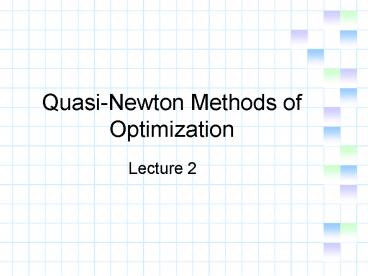QuasiNewton Methods of Optimization - PowerPoint PPT Presentation
1 / 29
Title:
QuasiNewton Methods of Optimization
Description:
Quasi-Newton algorithms involve an approximation to the Hessian matrix. ... An alternative is to reconfigure the Hessian by letting the numeric be the 1/2 ... – PowerPoint PPT presentation
Number of Views:341
Avg rating:3.0/5.0
Title: QuasiNewton Methods of Optimization
1
Quasi-Newton Methods of Optimization
- Lecture 2
2
General Algorithm
- A Baseline Scenario
- Algorithm U (Model algorithm for n-dimensional
unconstrained minimization). Let xk be the
current estimate of x. - U1. Test for convergence If the conditions for
convergence are satisfied, the algorithm
terminates with xk as the solution. - U2. Compute a search direction Compute a
non-zero n-vector pk, the direction of the search.
3
General Algorithm
- U3. Compute a step length Compute a scalar ak,
the step length, for which f(xk akpk )ltf(xk). - U4. Update the estimate of the minimum Set xk1
xk ak pk, kk1, and go back to step U1. - Given the steps to the prototype algorithm, I
want to develop a sample problem that we can
compare the various algorithms against.
4
General Algorithm
- Using Newton-Raphson, the optimal point for this
problem is found in 10 iterations using 1.23
seconds on the DEC Alpha.
5
Derivation of the Quasi-Newton Algorithm
- An Overview of Newton and Quasi-Newton Algorithms
- The Newton-Raphson methodology can be used in U2
in the prototype algorithm. Specifically, the
search direction can be determined by
6
Derivation of the Quasi-Newton Algorithm
- Quasi-Newton algorithms involve an approximation
to the Hessian matrix. For example, we could
replace the Hessian matrix with the negative of
the identity matrix for the maximization problem.
In this case the search direction would be
7
Derivation of the Quasi-Newton Algorithm
- This replacement is referred to as the steepest
descent method. In our sample problem, this
methodology requires 990 iterations and 29.28
seconds on the DEC Alpha. - The steepest descent method requires more overall
iterations. In this example, the steepest
descent method requires 99 times as many
iterations as the Newton-Raphson method.
8
Derivation of the Quasi-Newton Algorithm
- Typically, the time spent on each iteration is
reduced. Again, in the current comparison each
the steepest descent method requires .123 seconds
per iteration while Newton-Raphson requires .030
seconds per iteration.
9
Derivation of the Quasi-Newton Algorithm
- Obviously substituting the identity matrix uses
no real information from the Hessian matrix. An
alternative to this drastic reduction would be to
systematically derive a matrix Hk which uses
curvature information akin to the Hessian matrix.
The projection could then be derived as
10
Derivation of the Quasi-Newton Algorithm
- Conjugate Gradient Methods
- One class of Quasi-Newton methods are the
conjugate gradient methods which build up
information on the Hessian matrix. - From our standard starting point, we take a
Taylor series expansion around the point xk sk
11
Derivation of the Quasi-Newton Algorithm
12
Derivation of the Quasi-Newton Algorithm
13
Derivation of the Quasi-Newton Algorithm
- One way to generate Bk1 is to start with the
current Bk and add new information on the current
solution
14
Derivation of the Quasi-Newton Algorithm
15
Derivation of the Quasi-Newton Algorithm
- The Rank-One update then involves choosing v to
be yk Bksk. Among other things, this update
will yield a symmetric Hessian matrix
16
Derivation of the Quasi-Newton Algorithm
- Other than the Rank-One update, no simple vector
will result in a symmetric Hessian. An
alternative is to reconfigure the Hessian by
letting the numeric be the 1/2 the sum of a
numeric approximation plus itself transposed.
This procedure yields the general update
17
DFP and BFGS
- Two prominent conjugate gradient methods are the
Davidon-Fletcher-Powell (DFP) update and the
Broyden-Fletcher-Goldfarb-Shanno (BFGS) update. - In the DFP update v is set equal to yk yielding
18
DFP and BFGS
- The BFGS update is then
19
DFP and BFGS
- A Numerical Example
- Using the previously specified problem and
starting with an identity matrix as the original
Hessian matrix, each algorithm was used to
maximize the utility function.
20
DFP and BFGS
- In discussing the difference in step, I will
focus on two attributes. - The first attribute is the relative length of the
step (the 2-norm). - The second attribute is the direction of the
step. Dividing each vector by its 2-norm yields
yields a normalized direction of the search
21
DFP and BFGS
22
Relative Performance
- The Rank One Approximation
- Iteration 1
23
Relative Performance
- Iteration 2
24
Relative Performance
- PSB
- Iteration 1
25
Relative Performance
- Iteration 2
26
Relative Performance
- DFP
- Iteration 1
27
Relative Performance
- Iteration 2
28
Relative Performance
- BFGS
- Iteration 1
29
Relative Performance
- Iteration 2































